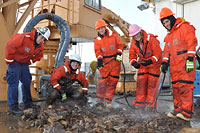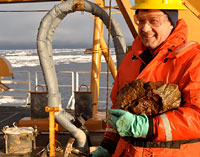

 | |||||||||||||||||||
|
|
Journals 2009/2010Jonathan Pazol
September 10, 2009 We've been dredging seamounts every day and for most of them have pretty much the same results - lots of sediment (mud), some manganese crust (manganese is a black element that forms and hardens on the outer sediment layer), some useful rocks, and ice rafted debris. Ice rafted debris (IRD) consists of rocks that have been carried from land by the ice and dropped to the ocean floor - sometimes hundreds of miles away. It tends to have rounded edges and scratch marks from the force of the ice, so geologists can tell that it is not a "native" part of the seamount.
On one of the dredges, the sensors reported very strong "hits" - periods of high tension, indicating that the dredge was caught on something and was hopefully prying it up. As it was being brought to the surface, the weight had increased by 1000 pounds, which made the geologists very optimistic. We put on our Mustang suits and got ready to go to work. I was assigned to be "Hose Girl" for this dredge, while Jennifer Henderson was named "Mud Boy" - I am told that these names are not really gender specific, they just sound better that way, so I went with it. When the dredge came up, it was filled with rocks and not just those that are IRD.
Geologists Kelley Brumley and Alex Andronikov were very excited with the contents. Rocks give clues to the geological history of a region and may help settle some debate as to how the various undersea formations developed. One piece of pillow basalt (a type of rock formed from volcanic action on land before being covered by water) was of special interest to Alex. On last year's cruise similar rocks were found, and further analysis of this piece will hopefully add even more information.
On today's dredge we also brought up some "critters" - as the geologists like to call them. The biologist in me was re-awakened, and I made sure that we salvaged the specimens to try to identify them. Despite the assistance of the Field Guide to Benthic Marine Invertebrates of the Alaska Shelf and Upper Slope, I was only able to make tentative identifications. One of the organisms looks like a shrimp, but it seems to belong to the Amphipod order - amphipods are related to the other arthropods, like shrimp, crabs, and even "pillbugs." The other one is also an invertebrate (animal without a backbone), and may be some type of crinoids. These animals have long stalks, which make them look like plants, but they are actually related to sea stars and sea urchins. Hopefully I can get some help with better identification once I return home.
|
||||||||||||||||||




